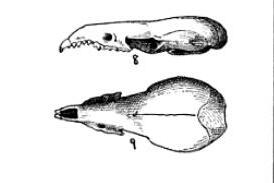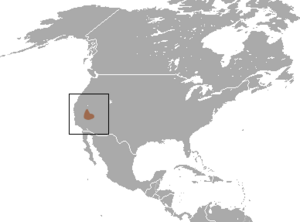Inyo shrew facts for kids
Quick facts for kids Inyo shrew |
|
|---|---|
 |
|
| Illustration of the skull | |
| Conservation status | |
| Scientific classification | |
| Genus: |
Sorex
|
| Species: |
tenellus
|
 |
|
| Inyo shrew range | |
| Synonyms | |
|
Sorex myops HHT Jackson, 1928 |
|
The Inyo shrew (Sorex tenellus) is a tiny mammal that lives in the western United States. It's a type of shrew, which are small, mouse-like creatures. This shrew is light gray and white. It has a narrow skull and a small body.
The Inyo shrew looks a lot like its cousin, the dwarf shrew (Sorex nanus). However, the Inyo shrew is usually paler and a bit smaller. You can find these shrews in many different places. They live in rocky mountains, wet areas, and along rivers. Not much is known about how they behave or have babies. Even though they haven't been studied much, scientists believe their numbers are steady. This means they are not currently in danger.
Contents
What is the Inyo Shrew's Family Tree?
The Inyo shrew was first officially described in 1895. A scientist named Clinton Hart Merriam gave it its name. He found the first known example near Lone Pine Creek in Inyo County, California.
At first, Merriam thought there were two types, or subspecies, of Inyo shrew. One was Sorex tenellus tenellus. The other was Sorex tenellus nanus. Later, Sorex tenellus nanus was recognized as its own separate species, the dwarf shrew (Sorex nanus).
Over time, other shrews that were once thought to be types of Inyo shrews were also given their own species status. For example, Sorex tenellus lyelli is now known as Sorex lyelli. Another one, Sorex tenellus myops, was also thought to be a separate species for a while. But in 1941, it was put back as a synonym of the Inyo shrew.
Sometimes, the Inyo shrew is called the Great Basin dwarf shrew. This helps tell it apart from the regular dwarf shrew. Scientists have done genetic studies to learn more about shrews. These studies help them understand how different shrew species are related to each other.
What Does the Inyo Shrew Look Like?
The Inyo shrew is a small animal with a pale color. Its fur on top is a light ash gray. Its belly and feet are white. Its tail has two colors: the top is darker than the white underside.
This shrew has a small, narrow, and very flat skull. There isn't much difference in size or looks between male and female Inyo shrews. They are usually about 85 to 103 millimeters (3.3 to 4.1 inches) long. Their tail is about 36 to 48 millimeters (1.4 to 1.9 inches) long. They weigh about 3.4 to 4.1 grams (0.12 to 0.14 ounces).
Compared to the dwarf shrew, the Inyo shrew is a little bigger. It also has a longer tail. It is also paler and grayer. Like other small shrews, the Inyo shrew changes its fur twice a year. It gets its summer coat in mid-to-late July. It likely gets its winter coat in October.
Where Do Inyo Shrews Live?
The Inyo shrew lives only in the United States. According to information from 2016, they are found in California and Nevada. However, in 2014, an Inyo shrew was found in Deep Creek Range, Utah. This was the first time one was seen in Utah and the farthest east they had been found.
These shrews live in many different places. They can be found in areas along rivers, at the bottom of canyons, and in rocky, mountainous regions. They also live in areas with red fir trees. They might be able to handle drier places quite well. Inyo shrews are usually found at high places, often above 2,300 meters (7,500 feet). They can also live in wetlands, though this is less common. Sometimes, Inyo shrews are found living in the same area as Preble's shrew (Sorex preblei). This has happened in Lassen Volcanic National Park in California.
What Do Inyo Shrews Eat and Do?
Scientists don't know much about the Inyo shrew's daily life, how it behaves, or how it reproduces. This is because they haven't been studied very much.
Inyo shrews mainly eat insects. They might also eat insect bodies that are carried by the wind to high places. They also eat other small invertebrates. These can include worms, mollusks (like snails), and centipedes. The Inyo shrew stays active all year long. In 1987, a new type of single-celled parasite was found in the feces (poop) of an Inyo shrew. This parasite was named Eimeria inyoni.
Are Inyo Shrews in Danger?
The International Union for the Conservation of Nature (IUCN) says the Inyo shrew is of "least concern." This means they are not worried about this species. Their population is stable, which means their numbers are not going down. They also live in several protected areas. There are no major threats that could harm the species. Scientists believe there are well over 10,000 adult Inyo shrews, and their population is staying strong.


